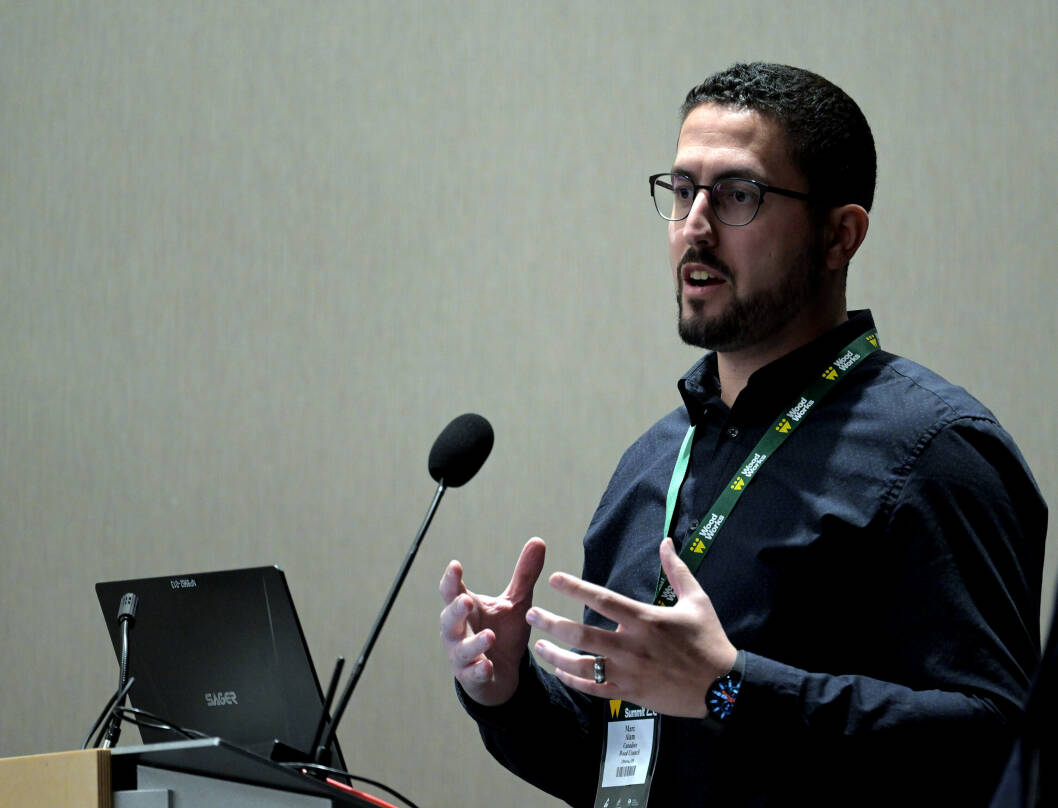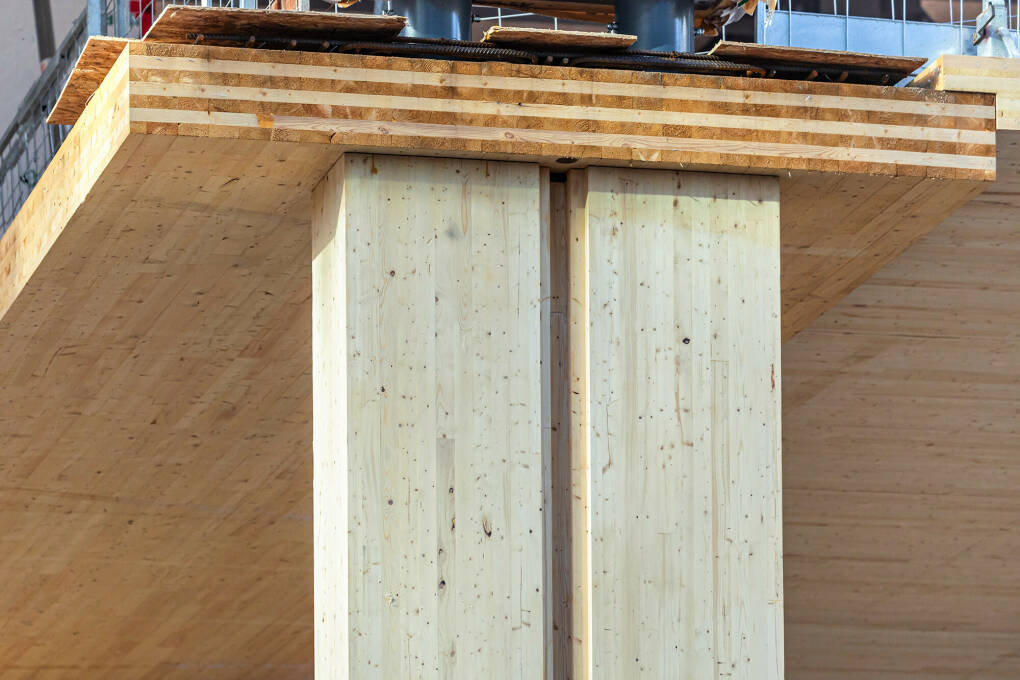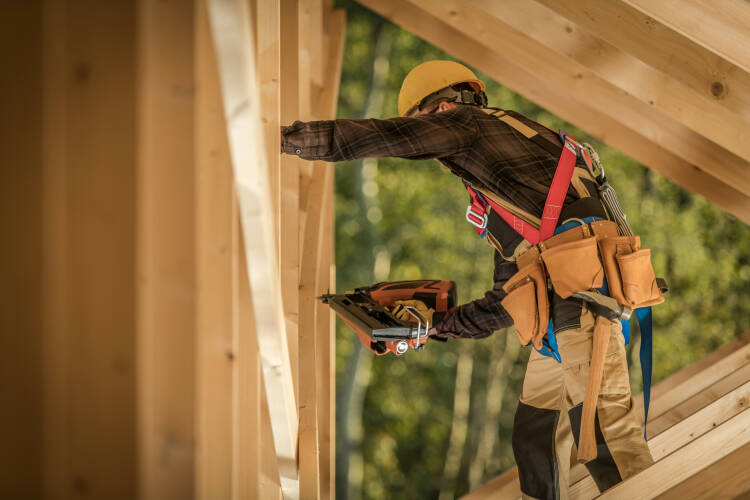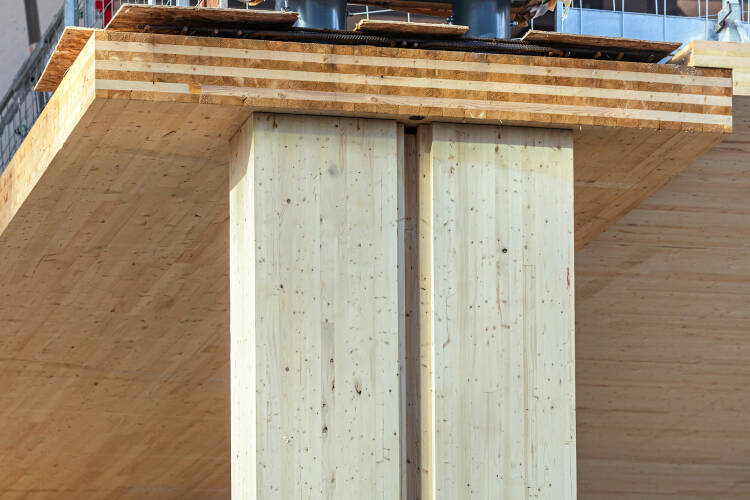Read more

Ecosystem Roadmap
Read more

Read more

Read more


Construction
The CWC has been very active with Canadian codes and standards meetings in 2023, particularly with respect to GHG emissions (carbon), alterations to existing buildings, wind resilience for houses and small buildings, and encapsulated mass timber (EMTC) provisions. Our codes and engineering team continues to advocate for the use of wood products in construction through engagement in current and future codes, standards, and policy development. Here are some of our 2023 highlights.

Top of Section

In 2023, the CWC’s codes and engineering team made significant strides in influencing the National Building Code (NBC) to include more favorable provisions for encapsulated mass timber construction (EMTC). These changes, once they come into effect in the 2025 NBC, will allow for taller CLT buildings and an increase in the amount of exposed mass timber permitted. This alignment with international standards is crucial for promoting wood as a viable material in modern construction, enabling broader use in tall structures, and supporting the industry's growth amid evolving sustainability demands. In parallel, we’ve been working with Quebec, Ontario, and BC to expedite these code changes for provincial code adoption in advance of the 2025 NBC.
CWC also continued work to address the undue conservatism introduced in the NBC 2020 related to seismic hazard data across Canada, which saw a significant increase in the west, resulting in added challenges for lateral design of mid-rise buildings using wood shearwalls. We are using modelling software and analysis to prove the undue conservatism, with verification from external consultants. This is important to ensure multi-storey wood shearwalls are more efficiently designed and to ensure mid-rise buildings in high seismic areas remain feasible.
In addition, operational carbon and embodied carbon objectives are expected to be added to the 2025 codes (National Building Code and National Energy Code for Buildings). CWC’s comments requesting refinement of the new objectives have been accepted positively by the respective standing committees. This work is critical for ensuring that wood products remain integral to global efforts in reducing carbon footprints, aligning with broader environmental goals.
Top of Section

The Canadian Wood Council has been pivotal in proposing and advancing technical changes to CSA O86, the Canadian Standard for Engineering Design in Wood. These changes, expected to be published in June 2024, will expand opportunities for wood in new systems.
CWC is also working proactively to derive Canadian values from PLIB foreign species data to validate the equivalency protocol for future O86 updates. This is needed to protect the Canadian lumber quality assurance system from alternative methods that would bypass the CWC and our partners, the NLGA and FPInnovations.CWC also continued work to address the undue conservatism introduced in the NBC 2020 related to seismic hazard data across Canada, which saw a significant increase in the west, resulting in added challenges for lateral design of mid-rise buildings using wood shearwalls. We are using modelling software and analysis to prove the undue conservatism, with verification from external consultants. This is important to ensure multi-storey wood shearwalls are more efficiently designed and to ensure mid-rise buildings in high seismic areas remain feasible.
Top of Section

Three members of the CWC’s Codes and Engineering team were selected from over 800 applicants to present at the 2023 World Conference on Timber Engineering (WCTE), hosted in Oslo, Norway. Marc Alam presented the changes to the National Building Code that the CWC spearheaded to allow increased use and exposure of wood in tall wood buildings during a session on global code development; Diego Flores shared results of his previous work on the fire performance of glued-in rod connections in a session on fire engineering; and Damian Oliveira presented equations developed at CWC for multi-storey CLT structures in a session on structural analysis.
Participation at the WCTE helps draw attention to the technical work in codes and standards produced by CWC. This international recognition enhances our technical credibility and positively impacts our reputation and level of influence in the Canadian codes and standards environment.


The Mass Timber Ecosystem Roadmap project, a collaborative effort undertaken this year with FPAC and the Transition Accelerator, aims to create a visionary roadmap for realizing Canada’s potential as a leading supplier of mass timber in a net-zero carbon economy. By engaging key stakeholders, the initiative has endeavoured to identify priority projects and foster a collaborative approach to advancing the mass timber industry. This project underscores the strategic importance of mass timber in achieving environmental goals and supporting the wood industry's sustainable growth. Publication of the roadmap will occur in 2024.
Top of Section
Read more

Ecosystem Roadmap
Read more

Read more

Read more

The CWC has been very active with Canadian codes and standards meetings in 2023, particularly with respect to GHG emissions (carbon), alterations to existing buildings, wind resilience for houses and small buildings, and encapsulated mass timber (EMTC) provisions. Our codes and engineering team continues to advocate for the use of wood products in construction through engagement in current and future codes, standards, and policy development. Here are some of our 2023 highlights.
Construction


In 2023, the CWC’s codes and engineering team made significant strides in influencing the National Building Code (NBC) to include more favorable provisions for encapsulated mass timber construction (EMTC). These changes, once they come into effect in the 2025 NBC, will allow for taller CLT buildings and an increase in the amount of exposed mass timber permitted. This alignment with international standards is crucial for promoting wood as a viable material in modern construction, enabling broader use in tall structures, and supporting the industry's growth amid evolving sustainability demands. In parallel, we’ve been working with Quebec, Ontario, and BC to expedite these code changes for provincial code adoption in advance of the 2025 NBC.
CWC also continued work to address the undue conservatism introduced in the NBC 2020 related to seismic hazard data across Canada, which saw a significant increase in the west, resulting in added challenges for lateral design of mid-rise buildings using wood shearwalls. We are using modelling software and analysis to prove the undue conservatism, with verification from external consultants. This is important to ensure multi-storey wood shearwalls are more efficiently designed and to ensure mid-rise buildings in high seismic areas remain feasible.
In addition, operational carbon and embodied carbon objectives are expected to be added to the 2025 codes (National Building Code and National Energy Code for Buildings). CWC’s comments requesting refinement of the new objectives have been accepted positively by the respective standing committees. This work is critical for ensuring that wood products remain integral to global efforts in reducing carbon footprints, aligning with broader environmental goals.

The Canadian Wood Council has been pivotal in proposing and advancing technical changes to CSA O86, the Canadian Standard for Engineering Design in Wood. These changes, expected to be published in June 2024, will expand opportunities for wood in new systems.
CWC is also working proactively to derive Canadian values from PLIB foreign species data to validate the equivalency protocol for future O86 updates. This is needed to protect the Canadian lumber quality assurance system from alternative methods that would bypass the CWC and our partners, the NLGA and FPInnovations.CWC also continued work to address the undue conservatism introduced in the NBC 2020 related to seismic hazard data across Canada, which saw a significant increase in the west, resulting in added challenges for lateral design of mid-rise buildings using wood shearwalls. We are using modelling software and analysis to prove the undue conservatism, with verification from external consultants. This is important to ensure multi-storey wood shearwalls are more efficiently designed and to ensure mid-rise buildings in high seismic areas remain feasible.

Three members of the CWC’s Codes and Engineering team were selected from over 800 applicants to present at the 2023 World Conference on Timber Engineering (WCTE), hosted in Oslo, Norway. Marc Alam presented the changes to the National Building Code that the CWC spearheaded to allow increased use and exposure of wood in tall wood buildings during a session on global code development; Diego Flores shared results of his previous work on the fire performance of glued-in rod connections in a session on fire engineering; and Damian Oliveira presented equations developed at CWC for multi-storey CLT structures in a session on structural analysis.
Participation at the WCTE helps draw attention to the technical work in codes and standards produced by CWC. This international recognition enhances our technical credibility and positively impacts our reputation and level of influence in the Canadian codes and standards environment.

The Mass Timber Ecosystem Roadmap project, a collaborative effort undertaken this year with FPAC and the Transition Accelerator, aims to create a visionary roadmap for realizing Canada’s potential as a leading supplier of mass timber in a net-zero carbon economy. By engaging key stakeholders, the initiative has endeavoured to identify priority projects and foster a collaborative approach to advancing the mass timber industry. This project underscores the strategic importance of mass timber in achieving environmental goals and supporting the wood industry's sustainable growth. Publication of the roadmap will occur in 2024.
